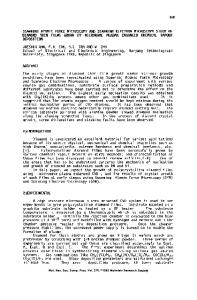Characterization of thin films containing zirconium, oxygen, and sulfur by scanning electron and atomic force microscopy
- PDF / 1,330,466 Bytes
- 9 Pages / 612 x 792 pts (letter) Page_size
- 93 Downloads / 374 Views
MATERIALS RESEARCH
Welcome
Comments
Help
Characterization of thin films containing zirconium, oxygen, and sulfur by scanning electron and atomic force microscopy A. Fischer, F.C. Jentoft,a) G. Weinberg, R. Schlo¨gl Fritz-Haber-Institut der Max-Planck-Gesellschaft, Abteilung Anorganische Chemie, Faradayweg 4-6, 14195 Berlin (Dahlem), Germany
T.P. Niesen, J. Bill, F. Aldinger Max-Planck-Institut fu¨r Metallforschung und Institut fu¨r Nichtmetallische Anorganische Materialien, Pulvermetallurgisches Laboratorium, Heisenbergstraße 5, 70569 Stuttgart, Germany
M.R. De Guire Department of Materials Science and Engineering, Case Western Reserve University, 10900 Euclid Avenue, Cleveland, Ohio 44106-7204
M. Ru¨hle Max-Planck-Institut fu¨r Metallforschung, Seestraße 92, 70174 Stuttgart, Germany (Received 1 February 1999; accepted 24 May 1999)
Oxidic zirconium films prepared by chemical deposition from aqueous medium on sulfonic acid terminated self-assembled monolayers attached to an oxidized silicon surface were investigated with scanning electron microscopy and atomic force microscopy. Bulk precipitate forms in the 4 mM Zr(SO4)2 ⭈ 4H2O, 0.4 N HCl deposition medium at 343 K after approximately 30 min. Precipitate particles (200 nm and larger) were found embedded in the oxidic zirconium film and adsorbed on top of the film; they could be washed off, but patches of the film were removed. Working with unstable deposition solutions, in which homogeneous nucleation occurs, leads to preparation-inherent flaws in the film.
I. INTRODUCTION
Zirconia coatings are of technical importance because of their thermal, mechanical, and chemical stability.1–4 Zirconia is an oxygen ion conductor and can serve as an electrolyte in solid oxide fuel cells5 or as an oxygen sensor.6,7 Optical applications of zirconia thin films are also under investigation.8,9 Our particular interest in zirconia thin films is the preparation of a model system to obtain better understanding of the acidic properties of sulfated zirconia-based materials, which have drawn attention as low-temperature isomerization catalysts.10,11 These applications create a demand for a preparation technique that yields high-quality zirconia thin films, i.e., films which are structurally uniform, dense, and adherent to the substrate. A number of techniques are available to prepare oxide films, among them sputtering, vapor deposition, plasma spraying, sol-gel processes (e.g., dip-coating and spin-coating), and electrochemical This study is related to “Atomic force microscopic studies of oxide thin films on organic self-assembled monolayers” by T.P. Niesen, M.R. De Guire, J. Bill, F. Aldinger, M. Ru¨hle, A. Fischer, F.C. Jentoft, and R. Schlo¨gl, published in Journal of Materials Research, Vol. 14, No. 6, pp. 2464–2475. a) Address all correspondence to this author. J. Mater. Res., Vol. 14, No. 9, Sep 1999
http://journals.cambridge.org
Downloaded: 19 Mar 2015
deposition; however, some of these techniques are expensive, and not all of them allow deposition of highquality films
Data Loading...











